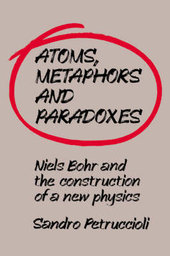
|
Atoms, Metaphors and Paradoxes: Niels Bohr and the Construction of a New Physics
Paperback / softback
Main Details
| Title |
Atoms, Metaphors and Paradoxes: Niels Bohr and the Construction of a New Physics
|
| Authors and Contributors |
By (author) Sandro Petruccioli
|
|
Translated by Ian McGilvray
|
| Physical Properties |
| Format:Paperback / softback | | Pages:252 | | Dimensions(mm): Height 228,Width 154 |
|
| Category/Genre | Quantum physics |
|---|
| ISBN/Barcode |
9780521031882
|
| Classifications | Dewey:530.1209 |
|---|
| Audience | | Professional & Vocational | |
|---|
| Illustrations |
Worked examples or Exercises
|
|
Publishing Details |
| Publisher |
Cambridge University Press
|
| Imprint |
Cambridge University Press
|
| Publication Date |
23 November 2006 |
| Publication Country |
United Kingdom
|
Description
This book gives a detailed study of the development and the interpretation given to Niels Bohr's Principle of Correspondence. It also describes the role that this principle played in guiding Bohr's research over the critical period from 1920 to 1927. Quantum mechanics, developed in the 1920s and 1930s by Bohr, Heisenberg, Born, Schroedinger and Dirac, represents one of the most profound turning points in science. This theory required a wholly new kind of physics in which many of the principles, concepts and models representing reality, that had formed the basis of classical physics since Galileo and Newton, had to be abandoned. This book re-examines the birth of quantum mechanics, in particular examining the development of crucial and original insights of Niels Bohr.
Reviews"The essays...are well written and well translated. Each has extensive endnotes and biliographic references. ...the book will be useful for advanced undergraduates doing research in this field. Libraries with extensive collections in the history and philosophy of science should seriously consider this work." Choice "...the text is enlightening on several points, and offers some original analysis." Dennie Dieks, Mathematical Reviews "...provides a clear insight for physicists and historians of science into how the established wisdom about the quantum world came about...Fascinating stuff..." John Gribbin, New Scientist "...well written and well translated...very useful name index and general index... will be useful for advanced undergraduates doing research in this field. Libraries with extensive collections in the history and philosophy of science should seriously consider this work." H.E. Wylen "...the best overall treatment of the background to the doctrine of complementarity." Edward McKinnon, Isis
|